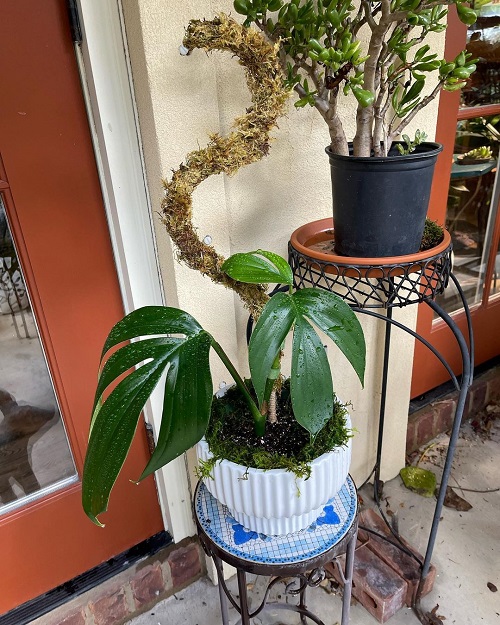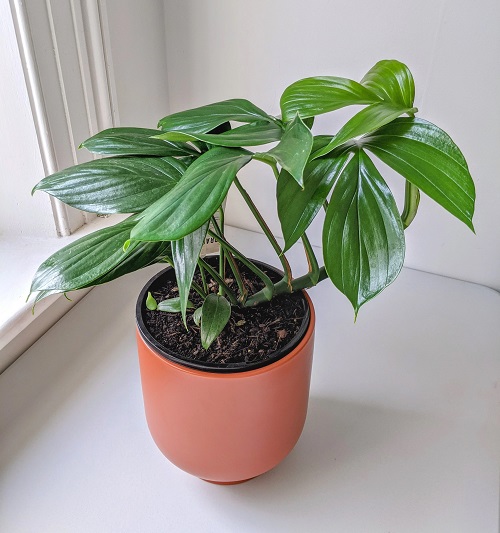Dragon Tail Philodendron is an easy to grow plant that stands out with its quirky foliage! Here are the details to grow it.

If you want an easy-to-maintain specimen that remains green all the time of the year, then Dragon Tail Philodendron is one of the best choices!
Dragon Tail Philodendron Plant Information
The Dragon Tail Philodendron is native to the tropical rainforests of South America. It produces glossy, elongated leaves that resemble the shape of a dragon’s tail, hence the name derived. This plant has a vining habit, and it can reach impressive lengths.
Botanical Name: Philodendron bipinnatifidum ‘Dragon Tail’
Propagating Dragon Tail Philodendron
Select a healthy stem from Dragon Tail Philodendron. Cut a portion of the stem just below a node. Trim off the lower leaves from the cutting, leaving only a few leaves at the top. Prepare a small pot or container with a well-draining potting mix. Make a hole in the soil using a pencil or your finger. Insert the cut end of the stem into the hole. Firmly press the soil around the stem.
Water the soil thoroughly after planting to settle it around the cutting. Maintain slightly moist but not overly wet soil throughout the propagation process. Avoid overwatering, as excessive moisture can lead to rot. Place the cutting in a location with bright, indirect light. Avoid direct sunlight, as it can scorch the leaves.
Roots may take several weeks or more to develop. During this time, ensure the soil remains slightly moist.
Requirements to Grow Dragon Tail Philodendron

Sunlight
Place the plant in a location that receives bright, indirect light. Avoid exposing it to direct sunlight, especially during the hot afternoon hours, as it can lead to sunburn and scorch the leaves.
Soil
Use a high-quality peat-based or organic potting mix for good moisture retention while allowing for adequate drainage. Avoid heavy or compacted soils that can retain too much water and lead to root rot.
Add perlite or vermiculite to the potting mix to improve drainage and aeration.
Watering
Before watering, allow the top 1-2 inches (2.5-5 cm) of the soil to dry out. Stick your finger into the soil to check the moisture level. If it feels dry at that depth, it’s time to water. Avoid overwatering, as this can lead to root rot.
Temperature and Humidity
Dragon Tail Philodendron prefers temperatures between 65°F to 85°F (18°C to 29°C). It can tolerate slightly lower temperatures but should be protected from frost and freezing conditions.
The ideal humidity level for the plant will be around 40% to 60%. You can increase humidity levels by misting the plant’s leaves regularly with water, placing a humidifier nearby, grouping plants together to create a microclimate, or using a pebble tray filled with water under the pot (ensure the pot is not sitting in water).
Dragon Tail Philodendron Care Tips
Fertlizer
Use a balanced, water-soluble houseplant fertilizer, such as a 10-10-10 or 20-20-20 formula. Alternatively, you can opt for a specialized indoor plant fertilizer specifically formulated for foliage plants.
Dilute the fertilizer according to the manufacturer’s instructions, usually at a rate of ¼ to ½ strength. Apply the diluted fertilizer every four to six weeks during the growing season, which is typically spring through summer. Reduce or stop fertilization during the winter months.
Pruning
Regularly inspect your Dragon Tail Philodendron for yellowed or diseased leaves. Trim these leaves close to the main stem using clean pruning shears or scissors. Removing diseased or dying foliage helps improve the overall health and appearance.
If your Dragon Tail Philodendron becomes too large or unruly, you can prune back the stems to manage its size and shape. Identify the areas that need trimming to achieve the desired form, and make clean cuts just above a leaf node or joint. This will encourage new growth and maintain a more compact shape.
Pests and Diseases
Mealybugs, spider mites, and aphids are common pests that affect Dragon Tail Philodendron. Regularly inspecting the plant for pests and using insecticidal soap will keep them at bay.
To keep most diseases away from the plant, avoid overwatering and ensure it has proper air circulation.




